 hen Mutlaq ibn Gublan
decided to dig a birka (pond) to keep his camels watered, he arranged for a backhoe and drums of
diesel fuel to be driven from the road to the site on his ancestral grazing lands in southwest Saudi Arabia.
The spot he had chosen, amid finger-like valleys that cut through low sandstone hills, was near traces of an
ancient waterfall, which hinted that, in millennia past, nature itself supplied more than a mere birka.
hen Mutlaq ibn Gublan
decided to dig a birka (pond) to keep his camels watered, he arranged for a backhoe and drums of
diesel fuel to be driven from the road to the site on his ancestral grazing lands in southwest Saudi Arabia.
The spot he had chosen, amid finger-like valleys that cut through low sandstone hills, was near traces of an
ancient waterfall, which hinted that, in millennia past, nature itself supplied more than a mere birka.
His pond was never completed. As he supervised the excavation, he says, "I spotted a smooth, shaped
stone sticking out of the ground. I recognized it was an old and important object." He could tell at
once it was a statue of an animal. It was buried upright, head toward the surface, he says. "I paid
off the operator and told him to follow his tracks back to the road."
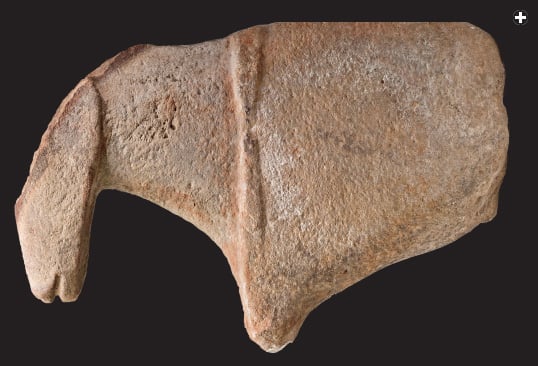 |
|
Saudi Commission for Tourism and Antiquities |
|
Above and top: The largest, and to date the most significant, of more than 300 artifacts found so far
at al-Magar is a sculpture fragment whose head, muzzle, nostrils, arched neck, shoulder, withers and
overall proportions resemble those of a horse, though it may represent an ass, an onager or a hybrid.
Eighty-six centimeters (34") long, 18 centimeters (7") thick and weighing more than 135 kilograms (300
lbs), it is provisionally dated to about 7000 bce.
|

Over the next few years, Ibn Gublan unearthed some 300 objects there. Though none was as large as the first,
his finds included a small stone menagerie: ostrich, sheep and goats; what may be fish and birds; a cow-like
bovid (Bovidae); and an elegant canine profile that resembles one of the oldest known domesticated
breeds, the desert saluki. In addition, he found mortars and pestles, grain grinders, a soapstone pot
ornamented with looping and hatched geometric motifs, weights likely used in weaving and stone tools that may
have been used in leather processing, as well as scrapers, arrowheads and blades—including an exquisitely
decorated stone knife in the unmistakable curved design of the traditional Arabian dagger.
 |
|
"I recognized it was an old and important object," says Mutlaq ibn Gublan, who canceled excavation
of his camel-watering pond when the excavator's backhoe struck the Neolithic sculpture. "I am happy
that in the footsteps of my grandfather and his long line of ancestors I have found something from
the heart of Arabia that goes deep into our history and helps connect us with the past."
|
Two years ago, he loaded it all up in his Jeep, drove it to Riyadh and donated it to the Saudi Commission for
Tourism and Antiquities (scta).
"When I first saw the pieces, I just could not believe it. It was, how can I say, incroyable,"
recalls Ali al-Ghabban, head of antiquities at the scta, his French-accented
English giving away his years at the University of Provence. "This is Neolithic material," he states,
from "a sophisticated society possessing a high level of art and craftsmanship that we have not previously
seen." Al-Ghabban had a laboratory run a radiocarbon analysis on trace organic remains found later alongside
some of the objects. That dated the material to between 6590 and 7250 bce, he says.
The discovery has been named "the al-Magar civilization" after its location, a name that means
"gathering place" or "headquarters" in a tribal context. It is the carvings of animals—far
more numerous, and some larger, than anything previously found in the western Arabian Peninsula—that are
the most intriguing. Among them, the largest, the one that prompted Ibn Gublan to stop the backhoe, has sparked
the most curiosity of all.
Eighty-six centimeters (34") long, 18 centimeters (7") thick and weighing more than 135 kilograms (300 lbs),
the carving has a rounded head, arched neck, muzzle, nostrils, shoulder, withers and overall proportions that
clearly resemble an equid—a horse, an ass, an onager or some hybrid. But what makes it so very curious
are its two distinctive tooled markings—one in relief from the shoulder down toward the forefoot, and
the other carefully, even delicately, incised around the muzzle. The question fairly leaps out: Were the people
who inhabited al-Magar putting early forms of bridles on such animals? If so, they were doing it millennia
before experts believe it was done elsewhere.
The discovery at al-Magar and the electrifying question it raises come as Saudi Arabia experiences a resurgent
pride not only in its archeological heritage but also, particularly, in the legacy and culture of the desert-bred
Arabian horse. The discovery also coincides with recent advances in analytical technologies that can help address
important questions: When and where did humans begin to move from hunting wild horses (Equus ferus) for
food, bone, hide and hair toward the capture, taming and exploitation of horses for meat, milk and transport—a
process that gave rise to the subspecies (Equus ferus caballus) that is today's domesticated horse? This
pivotal historic development revolutionized transport and trade, allowed people to connect over much larger distances,
speeded migrations and changed conquest and warfare. Yet despite more than a century of archeology and the latest
in genetic technology, it remains an open question exactly when, where and how domestication occurred. The discovery
at al-Magar shows again just how very open a question it is.
 hen Ibn Gublan removes from
a document case a sheaf of neatly clipped and plastic-protected press clippings, in both Arabic and English,
and fans them out in the tented majlis (salon) of his brother's home, it is the picture of the banded
and incised equid-like statue that takes pride of place. In a scholarly manner, he adjusts his thick-rimmed
glasses and peers at a photograph of Saudi King Abdullah bin 'Abd al-'Aziz examining the objects last year,
when the discovery was announced and the finds were first displayed to dignitaries and high government officials.
hen Ibn Gublan removes from
a document case a sheaf of neatly clipped and plastic-protected press clippings, in both Arabic and English,
and fans them out in the tented majlis (salon) of his brother's home, it is the picture of the banded
and incised equid-like statue that takes pride of place. In a scholarly manner, he adjusts his thick-rimmed
glasses and peers at a photograph of Saudi King Abdullah bin 'Abd al-'Aziz examining the objects last year,
when the discovery was announced and the finds were first displayed to dignitaries and high government officials.
With mint tea brewing on the hearth and Arab coffee deftly served by his young nephew Saud, attention turns to
this prize statue. It is the centerpiece of a new archeological discussion, and its initial interpretation is as
challenging and contentious as it is intriguing.
A wet epoch in Arabia, starting after the last Ice Age, about 10,000 years ago, and enduring for about 5000 years,
allowed widely varied flora and fauna to flourish. Evidence of this is abundant in rock art throughout the western
Arabian Peninsula, where depictions of various equids appear along with other species, such as cheetah, hippo,
hyena and giraffe, which disappeared as the climate dried to desert. How and when the horse appeared is a matter
of both emerging science and Saudi cultural pride—this latter evidenced not only by today's pride in Arabian
horses, but also by the rich legacy of poetry and legend, going back deep into pre-Islamic times, that surround
and celebrate the desert-bred Arabian horse.
The sculptures from al-Magar "might be" equids, says David Anthony, author of The Horse, The Wheel,
and Language and a leading authority on the domestication of the horse. "The local equid in southern
Mesopotamia was the onager, and another was the ass, introduced probably from Egypt. No Equus caballus
specimens have been found, to my knowledge, anywhere near Saudi Arabia before 1800 bce."
For anything conclusive, he continues, "there need to be finds of definite Equus ferus caballus bones
in a good stratified context dated by radiocarbon."
In March 2010, the scta flew Saudi and international archeologists and pre-historians
to al-Magar for a brief daytime survey. The team fanned out and, in a few hours, collected more stone objects,
including tools and another horse-like statue. They also sifted out four samples of burned bone, which were later
used for radiocarbon dating of the site. The date, about 9000 years before the present, coincides with the period
when the inhabitants of the first known settlements in Arabia and the Levant, already starting to cultivate crops,
were also beginning to domesticate animals.
With the area now monitored to prevent illicit digging, the scta is preparing for
detailed surveys and excavations expected to take years. "This impressive discovery reflects the importance of
the site as a cultural center and could possibly be the birthplace of an advanced prehistoric civilization that
witnessed domestication of animals for the first time during the Neolithic period," says al-Ghabban. "We
now need to know more."
 ll current evidence points to
the Eurasian steppe, and probably not much earlier than around 4000 bce," as
the place and time the horse was first domesticated, says zooarcheologist Sandra Olsen, head of anthropology and
director of the Center for World Cultures at the Carnegie Museum of Natural History. Olsen has studied the roles
of horses in human cultures since 1975 and pioneered research on horse domestication. She and her colleagues have
documented the oldest evidence for domestic horses known to date: It comes from about 3500 bce,
in northern Kazakhstan.
ll current evidence points to
the Eurasian steppe, and probably not much earlier than around 4000 bce," as
the place and time the horse was first domesticated, says zooarcheologist Sandra Olsen, head of anthropology and
director of the Center for World Cultures at the Carnegie Museum of Natural History. Olsen has studied the roles
of horses in human cultures since 1975 and pioneered research on horse domestication. She and her colleagues have
documented the oldest evidence for domestic horses known to date: It comes from about 3500 bce,
in northern Kazakhstan.
In 2010 and 2011, Olsen joined Majid Khan, a specialist on Arabian rock art, in Saudi Arabia for a kingdom-wide
survey of known rock art that shows equids—and a quest for new finds. Khan has spent the last three decades
investigating Saudi petroglyphs, and he estimates there are more than 1000 that portray equids as hunted, ridden
or draft animals. He believes the earliest among them date back into the Neolithic era—though assigning
accurate dates is notoriously challenging.
 |
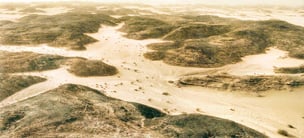 |
|
Al-Magar lies amid the low hills and sandy valleys of southwestern Saudi Arabia, which until
4000 or 5000 years ago was as verdant as African savannah today.
|
Given the limitations of the archeological record, how can archeologists make progress in identifying where and
when the long process of domestication actually began? Olsen describes her team's approach as "holistic,"
or simply, "piecing together as much evidence as possible, whether direct or more circumstantial." In the
steppes of Asia, she adds, "we also take an 'upside-down' approach: If the prehistoric horse bones are difficult
to decipher, then why not look at the settlement and at traces of the human lifestyle for evidence that they were
affected by horse domestication?"
According to al-Ghabban, it is just such a multidisciplinary approach that will be applied at al-Magar, where
specialists will include zooarcheologists, geoarcheologists, archeobotanists, paleoclimatologists, petrologists,
paleontologists, authorities on the domestication of flora and fauna, and archeogeneticists, who will likely be
enlisted to use relatively new mitochondrial DNA (mtDNA) analysis. What makes mtDNA analysis particularly useful
is that—unlike nuclear DNA—mtDNA resides outside a cell's nucleus, which means it is inherited exclusively
through the maternal line, unshuffled from generation to generation. MtDNA studies comparing a range of domestic
horse breeds reveal high diversity among maternal lines, or matrilines. This diversity, Olsen says, supports the
theory that horse domestication took place in a number of different places at different times. "There was no
one ancestral mare that was the 'Eve' of all domestic horses," she says.
Supporting this view is a study published in January in the journal of the us
National Academy of Sciences that examines the rate of mutation of equine mtdna. It not only concludes that
communities in both Asia and Europe domesticated horses independently, but also suggests how far back in time
domestication events may have taken place. Alessandro Achilli, assistant professor of genetics in the Department
of Cellular and Environmental Biology at the University of Perugia in Italy, collected maternally inherited
mitochondrial genomes from living horses in Asia, Europe, the Middle East and the Americas. Because mtDNA mutation
occurs at a known rate, these samples allowed him to trace maternal ancestry using a kind of "molecular clock."
|
naturefolio / alamy; blickwinkel / alamy; daniel pickering |
 |
|
Equid species known to Neolithic humans in Africa and Asia included the African wild ass, Equus africanus
somalicus, above; the onager, Equus hemionus onager, right; and the early wild horse, Equus ferus, opposite,
from which today's domestic horse species are descended.
|
His team identified maternal lines descending unambiguously from different female ancestors. "This means that
multiple female horse lines were domesticated throughout the Neolithic period—during the last 10,000 years—in
multiple locations of Eurasia, possibly including western Europe," says Achilli. "The very fact that many
wild mares were independently domesticated in different places testifies to how significant horses have been to humankind.
Taming these animals could generate the food surplus necessary to support the growth of human populations and the human
capability to expand and adapt to new environments, or could facilitate transportation." Achilli adds
that "unfortunately, we have no idea about the exact location of the domestication events," a question that
only archeological dna sampling can answer.
Olsen, though inclined to agree, cautions against accepting this as any kind of last word. She argues that humans and
wild animals, as well as horses, all have different maternal lines. "I think that these multiple matrilines are
the result of ancient horse herders occasionally catching and adding wild mares to their breeding populations,"
she says. And, she adds, in the other direction, "domesticated mares can be 'stolen' by wild stallions and
incorporated into their harems."

However it took place, the generally accepted scenario of multiple, separate domestication events does open the
tantalizing possibility that the Arabian Peninsula had its own horse-domestication event, and the Peninsula's last wet
climatic period would seem like an ideal epoch for that to have occurred, if indeed it did. While Arabian domestication
implies that there would have been wild horses roaming a then-verdant, savannah-like landscape, Olsen believes that
picture is not supported by the petroglyphs she has seen in the country, nor by any skeletal remains, which have yet to
be found. Although she accepts that wild asses or onagers are shown being hunted in Neolithic Saudi petroglyphs, she
contends that the earliest horses she has seen on the Peninsula are those depicted with chariots, and those, she says,
are "no older than at the most 2000 bce." That shows "why I believe it
is imperative to distinguish between wild asses and hemiones [onagers] versus horses."
 |
|
Unambiguously domesticated horses appear in petroglyphs dating back to the second or late third millennium
bce. The mounted hunter, above left, and the two-horse chariot, above right, are both
from northwestern Saudi Arabia. The chariot of similar appearance, below lef, was drawn in southern Libya.
|
 |
|
lars bjurstrom / sawdia; richard t. bryant; roberto esposti / alamy; bridgeman art library |
 s in all detective work, one of the great dangers is flawed evidence. Nearly half a century ago in the Ukraine, a
Soviet archeologist uncovered the skull and lower leg bones of a young stallion at Dereivka, near the banks of the
Dnieper River. Radiocarbon analysis dated the find at 4200 to 3700 bce, and the
stallion's premolars showed signs of wear by a bit. Soviet archeologists confidently pronounced that the site was
evidence of horse domestication. But the find's importance collapsed when more detailed radiocarbon dating showed
that the remains were what archeologists call "an intrusive deposit" placed there by Iron Age Scythians
in the first millennium bce.
s in all detective work, one of the great dangers is flawed evidence. Nearly half a century ago in the Ukraine, a
Soviet archeologist uncovered the skull and lower leg bones of a young stallion at Dereivka, near the banks of the
Dnieper River. Radiocarbon analysis dated the find at 4200 to 3700 bce, and the
stallion's premolars showed signs of wear by a bit. Soviet archeologists confidently pronounced that the site was
evidence of horse domestication. But the find's importance collapsed when more detailed radiocarbon dating showed
that the remains were what archeologists call "an intrusive deposit" placed there by Iron Age Scythians
in the first millennium bce.
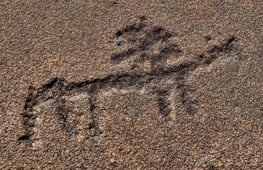 |
|
This simple, even crude, petroglyph near al-Magar may show a mounted rider.
|
Subsequently, studies have looked not only for evidence of horses being ridden but also for evidence of their
being herded. Attention shifted east, over the Ural Mountains, to the northern marches of Kazakhstan, where in
the 1980's, near a small village called Botai, Viktor Zaibert of Kokshetau University unearthed horse
bones—300,000 of them.
Zaibert, collaborating with American and British archeologists, found traces of bit wear on lower-jaw teeth,
revealing that around 3500 bce some Botai horses were indeed probably harnessed,
either for draft purposes or for riding, or both.
Olsen was among Zaibert's collaborators, and she identified in Botai traces of corrals and of roofing material
that contained horse manure, as well as signs of ceremonial sacrifices. She also found tools used to make leather
straps that may have served as bridles or hobbles. This is parallel to some of the stone tools found at al-Magar,
which also point to the likelihood of leather or fiber processing, which could be associated with items of horse
tack. But however significant indirect evidence may be, one of the lessons from Botai is that if al-Magar is to inform
us, then it is not only reliable taxonomy of the statuary, or interpretation of artifacts, that is required, but
also organic remains.
It was Alan Outram, a professor of archeological science at Exeter University, who found fat residues absorbed in
Botai pottery that were later determined to be from milk rather than meat. The overwhelming proliferation of horse
bones on the site logically suggested mare's milk, which to this day remains a popular traditional drink throughout
Central Asia. The thousands of horse bones, found in 150 house pits, show these horses were slender, like later
Bronze Age domestic horses, distinct from the more robust wild horses that once roamed the Eurasian lands from the
steppe to Iberia. Nevertheless, "in our science it is very difficult to determine whether the horse was
domesticated or not. The answer to this question is based on a complex study of all contexts of the material
culture," says Zaibert.
Olsen homes in on the bones: "Hunters abandon heavy bones of low utility at faraway kill sites, whereas herders
slaughter domestic animals in or near their village. In the latter case, all of the bones of the skeleton are found
at the home site, and that is exactly what appears at the Botai sites." Soil analysis in enclosures at one Botai
site identified high levels of phosphate and sodium, indicating that manure and urine were present inside what were
likely corrals, and Olsen has found signs of postholes around some, reinforcing the idea that at Botai, people corralled
some of their horses. These enclosures, as well as houses set in circles and rows, all point toward a kind of social
organization that could lend itself to horse domestication.
Just as Botai included developed settlements, the discovery at al-Magar includes traces of stone structures. Abdullah
al-Sharekh, an archeologist at King Sa'ud University, was among the first experts on the site. He was impressed with
the large number of scattered stone structural remains connected with settlement and with signs of agricultural activity
that he saw around the site, as well as along the tops of surrounding hills, including walls erected along the slopes.
The buried statues were all found within the remains of a building. "Nothing this size has been found in Arabia
before, and the stratigraphic evidence will make this perhaps the most significant site in Saudi Arabia," says
al-Sharekh. "In a regional context, a find of such variety must have significance. It can tell us about social
aspects and the culture of the people who lived here, domestication, trade and migration, and perhaps any early ritualistic
importance," he says, adding that "a pause is needed before we can make judgments."
Also present on the scta's initial survey team was Michael Petraglia, a specialist in
Paleolithic archeology and stone-tool technologies of the Arabian Peninsula. He quickly found at al-Magar a far older
historical horizon. Adjacent to the Neolithic finds, he found flaked stone tools, such as scrapers, that he estimates
exceed 50,000 years in age. Al-Magar "was an attractive environment for human activity over multiple periods,"
he says. "This is very important not only for the more recent site, but also for what it can tell us about past
climatic fluctuations between dry and humid periods."

It also makes al-Magar all the more intriguing as a possible site of early horse domestication. The equid-like sculpture's
prominent bas-relief band, which could represent a halter, is not unique: Other, smaller, equid-like statues from the
site also have bands across the shoulder. There is also on this largest piece the incision around the muzzle to the middle
of the upper jaw, which resembles a noseband. Do these features portray tack, or do they represent natural aspects of the
animal itself, such as musculature or coat markings? (The question has been posed before: In the 1980's, analysts of
Paleolithic paintings in French caves advanced claims that certain markings on horses indicated halters and consequently
suggested that domestication in Europe dated back as far as 25,000 years. World authorities, including Olsen, debunked this
by showing that the markings portrayed body features and hair patterns, not halters.)
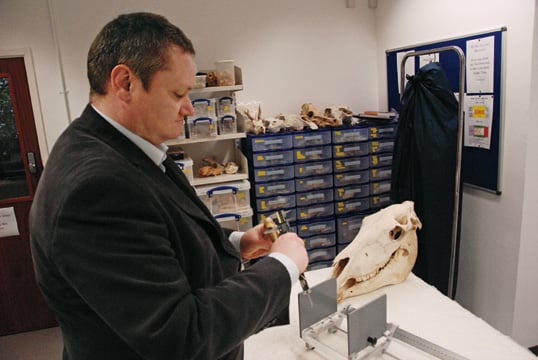 |
|
Alan Outram hopes for the chance to examine horse teeth that may be found at al-Magar
to see if they would show characteristic effects of wear caused by leather bits.
|
Before the use of metals, halters, reins and other tack were made entirely from natural materials, and among the al-Magar
finds are stone implements that may have been used to produce long strips of leather from the hides of sheep, goats or equids.
Al-Ghabban is particularly intrigued by a semi-spherical black stone with a deeply cut, rounded cleft worn smooth. Curious
lines are scored on either side of the gap. "We have not seen anything like this before, and we need to carefully study
this piece and what it tells us about processing leather and making rope and cord," he says.
Outram explains its potential significance. "As a culture develops away from hunting and gathering and toward such
activities as horse herding, the tool kit people use changes. We find more scrapers than pointed projectiles, as well as
entirely new processing tools," he says, pointing to such similar tools at Botai sites as leather thong smoothers
carved from horse jawbones. Outram has conducted laboratory simulations using tools recreated from horse mandibles, processing
thongs that could have been used as tack or tethers.
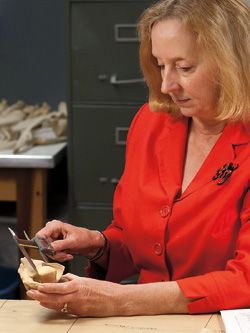 |
|
Joshua franzos |
 |
|
Sandra Olsen, top, has found the oldest firm evidence for domestic horses known to date, circa 3500
bce, at Botai in northern Kazakhstan, where organic remains at house sites, above,
help patches of vegetation grow thicker and greener.
|
Tack made from organic materials rarely survives in the archeological record, and thus stone tools, petroglyphs and equine
dental wear must provide the evidence of pre-metal-age bits on equids. To establish whether soft bits leave dental wear
patterns, and what those might look like, David Anthony pioneered experiments with bits made from leather, hemp and horsehair
rope, which he kept in place with cheek pieces made with flint tools. Comparing before-and-after equine dental mouldings, he
found that the organic bits created beveled wear that indeed differs from the abrasion patterns known from metal bits.
"The date when Equus caballus was introduced into northern and eastern Arabia has been debated since the 19th
century," says Michael Macdonald, a research associate at the Faculty of Oriental Studies, University of Oxford. Writing
15 years ago on the horse in pre-Islamic Arabia, he explains that controversy is to be expected until considerably more research
is carried out. "It will be many years before a coherent picture emerges," he says.
But there is no controversy that al-Magar constitutes a significant discovery. To Khan, it represents the earliest known
Neolithic settlement in the Arabian Peninsula and provides "solid and undeniable evidence of the presence and domestication
of horses in Arabia." He backs up his claim not only with the statuary but also with the discovery, within a few minutes'
walk of the site, of petroglyphs showing ostriches, dogs and ibex. One image, deeply pecked into the rock and with a heavy patina
of oxides built up over millennia, hints at a figure mounted on an animal. Khan is convinced it portrays a rider and a horse, and
he considers it Neolithic, contemporary with the oldest rock art he has studied so thoroughly at Jubbah, near Hail in northern
Saudi Arabia.
Others remain cautious. Juris Zarins, chief archeologist of the expedition that in 1992 discovered the "lost" city
of 'Ubar, and who worked in the early days of archeology in Saudi Arabia in the 1970's, says that he is "not surprised"
at the finds because al-Magar belongs to a region that is "an archeological hotbed," and that it is "not out of the
realm of possibility" that the markings could be the first hints of domestication. "There has not been enough exploration
carried out in Arabia," he says, "and new discoveries like this could change things." Whatever the species the
sculptures represent, he agrees the nose marking in particular could be significant. "In Arabia in the Neolithic period, we
have tethering stones, which archeologists say represent the first attempts at domestication. I think it is Equus asinus
[African wild ass]. They may have been trying to do something with it, based on the head. The earliest suggested Equus asinus
domestication in the Levant is generally regarded as 3500 bce. If so, this could mark the start of
a much longer-than-expected domestication process."
Olsen argues for careful study. The upstanding band could, she says, represent natural features of the animal, or it might even
be a tang for attaching the carving to a wall. "And where's the mane?" she asks, elaborating that she would expect equid
statuary to show the feature, whether upright as on wild horses or floppy like those on domesticated ones. "What is clearly
needed now," she suggests, "is a detailed and expert anatomical analysis of all of the animal heads in order to assess
their taxonomic identification."
Beyond this, the discovery of al-Magar, she says, "is extremely important in shedding light on an apparently new culture
that existed at a sophisticated level in a local region previously not known for this."
Mutlaq ibn Gublan draws on a lifetime spent with domesticated herds, including, of course, camels. He sips his coffee and
says, "When I saw the piece, and the large marking on it, I first thought it was an ox. But then its face told me this
is a horse. I am happy that in the footsteps of my grandfather and his long line of ancestors I have found something from the
heart of Arabia that goes deep into our history and helps connect us with the past." Just what that thing is will, for
now, remain a mystery.
 |
Peter Harrigan (harrigan@fastmail.fm), a frequent
contributor to this magazine, is a visiting researcher at the Institute of Arab and Islamic Studies at Exeter
University and commissioning editor of four books on Arabian horses. He lives on the Isle of Wight. |